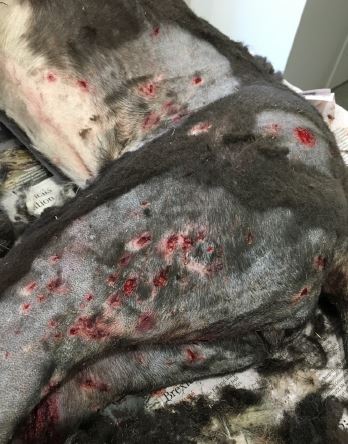Grass seeds in animals
As we approach the grass seed season this is a timely reminder to protect our canine friends. The innocuous looking Barley Grass seeds can cause a surprising amount of harm to animals. The pointed end of the seed can easily become embedded in skin, often between toes, in eyes, in the mouth, down ears or even up noses. We have had several cases so far this year and if not found and removed early enough, the seeds can migrate through the body tracking infection with them.
It is coming up to grass seed season again. Barley grass seeds are the common ones we see causing problems in the North East. Barley grass is an annual weed with an awned seed head. The innocuous looking little seeds can cause a surprising amount of harm to animals. The pointed end of the seed can easily become embedded in skin, often in between toes, in eyes, in mouth, down ears, or even up noses. They get caught in sheep wool and reduce fleece value. If not found and removed early enough the seeds can disappear in under the skin and migrate through the body, tracking infection with them. Sometime dogs will breathe grass seeds in, which can cause severe chest infections and may be fatal.
Seeds only form in long grass, so keep grass short at home over spring and summer and don’t allow your animals to go into long grass during your walks. Barley grass can be controlled in pastures through timed grazing management after the autumn break or herbicides at the start of spring growth or after seed head emergence.
Keep your pet’s hair short as seeds are more likely to get caught in long hair. It can be particularly helpful to keep the hair of the paws and ears as short as possible.
Check your pet for grass seeds every day, particularly in between every toe, under the tail, and in the armpit and groin regions. If a grass seed is too deep for you to remove, or if you can only see a small pink lump or wound rather than the actual seed, then it is best to have your pet seen by a vet as soon as possible before the seed has time to travel any further. The longer a seed is left, the harder it can be to locate and remove.
Other signs of grass seeds can be lameness, licking at paws, sudden onset of head shaking, sneezing, swelling and discharge from an eye, or pawing at an ear, eye or nose. If you notice any of these symptoms it is important to take your animal to a vet.

Photo: a particularly severe case of grass seeds in a dog
Linda Bradbury Warby Street Veterinary Hospital, Wangaratta. (03) 5721 7177
